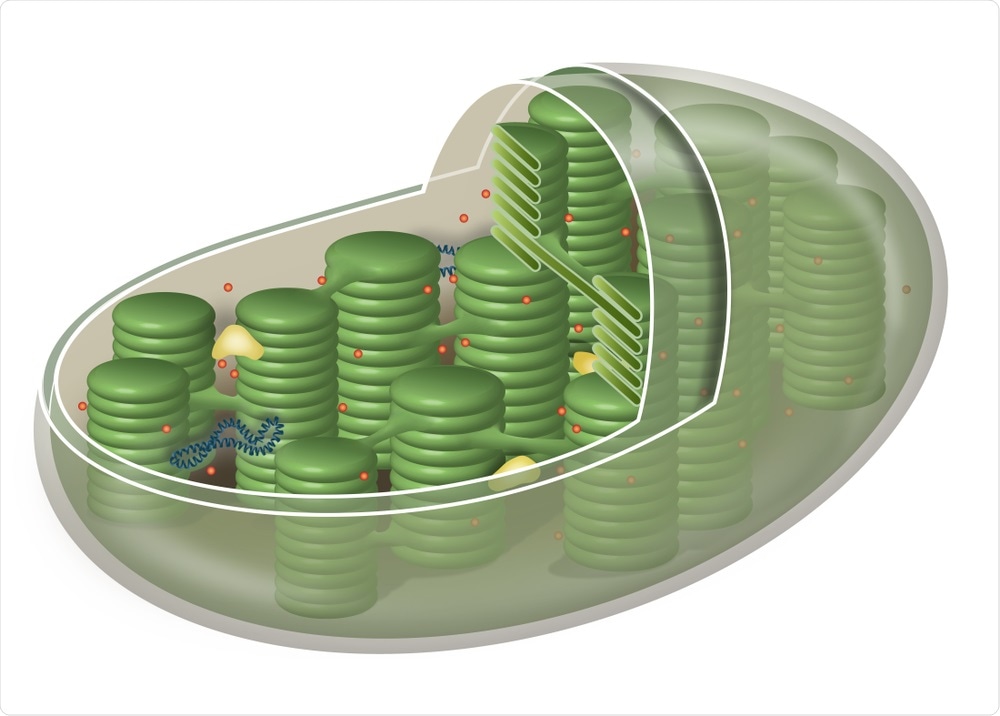Geneticists at the University of Tokyo have developed a new gene-editing technique that modifies the chloroplast of plant cells and is then able to remove the DNA editing tool to prevent changes from being inherited in future seeds.

Chloroplasts in Plant Cell. Image Credit: Aldona Griskeviciene/Shutterstock.com
Adapting and improving new chloroplast-targeting methods in plant gene editing
Food security is facing several challenges that may be solved through changes in agricultural production including the use of stronger, healthier, and faster-growing plants, which can be achieved through genetic engineering.
Across recent decades, methods have been developed to engineer better crops but have faced many technical challenges as well as popular controversies.
In a recent proof of concept study, a new approach developed by geneticists at the University of Tokyo now offers an alternative approach that could overcome certain limitations by modifying the chloroplasts within plant cells and removing the DNA editing tool to prevent heritability of changes.
The experiments were published in the journal Nature and were led by Associate Professor Shin-ichi Arimura who stated "Now we've got a way to modify chloroplast genes specifically and measure their potential to make a good plant".
The functional role of chloroplasts is to convert carbon dioxide and sunlight into sugar during photosynthesis. Chloroplasts have their own circular DNA distinct from nuclear DNA sequences but are made of the same amino acid coding. The appeal of targeting chloroplast is that the contained DNA is maintained and inherited completely separately from nuclear DNA.
Previous studies have attempted to insert new DNA fragments into chloroplast genomes, but this method also inserts extra genetic tags or markers that remained in the chloroplast.
The goal of this new method was to make uniform and inheritable changes to specific DNA parts of the chloroplast without leaving any genome editing tools or any changes to nuclear DNA. To achieve this the team started using TALENs, which uses a large protein recognizing specific short DNA sequences and cuts it through with an enzyme.
Researchers then used more recent technology as TALENs are now able to be customized to recognize key sequences in DNA sequences and the enzyme used can now replace GC pairs of amino acids with AT pairs, providing key actionable changes referred to as point mutations.
Prof. Arimura combined these techniques with further chloroplast-targeting methods, calling their finalized method the ptpTALECDs, and were required to make matching left and right pair of ptpTALECDs in bacteria for every change in the genome they desired.
The DNA sequences were then inserted into Arabidopsis thaliana plants, which are often used as representative model species for a wide variety of other crop species. Results showed that the changes were successful in altering gene expression in key traits and that the changes were not inherited across generations.
Chloroplast DNA encodes less than 1% of the total genetic material in a plant, but it has a very important effect on photosynthesis, and therefore the health of the plant. Hopefully, this method will be useful in fundamental research and applied agriculture,"
Arimura
Changes in chloroplast functioning can be explored further as energy production and expenditure are key features for plant survival. This is of particular importance considering changes in environmental conditions, for which plants will require to adapt or will otherwise succumb to physiologically demanding conditions.
Appeasing public concern through alternative gene-editing techniques
Another key facet of the present study is that this newly designed method is not technically considered gene editing, and may provide a middle ground to appease the public concern over the use of genetically modified organisms (GMOs).
Broadly speaking, countries assess GMOs by their end-product, and the new method, therefore, does not count as changes in chloroplasts are not inherited past the second generation. Offspring past the edited plants, therefore, do not present any changes in nuclear DNA and serve as “unaltered” crops.
Indeed, plants always inherit their chloroplasts whole and intact through their "mothers," the ovules. Therefore, if their female parent plant had modified chloroplasts, the next generation will always inherit modified chloroplasts regardless of nuclear DNA. Second-generation plants and any of their future offspring then be considered non-GMO end products because their nuclear DNA contains none of the ptpTALECDs' genetic engineering machinery.
The research team is therefore optimistic that the fact that none of the genetic engineering tools are inherited by future generations and that the method only makes point mutations will ensure that the method will be used to breed healthier crops that are accepted by farmers and consumers.
Journal reference:
- Nakazato, I., Okuno, M., Yamamoto, H. et al. Targeted base editing in the plastid genome of Arabidopsis thaliana. Nat. Plants (2021). https://doi.org/10.1038/s41477-021-00954-6